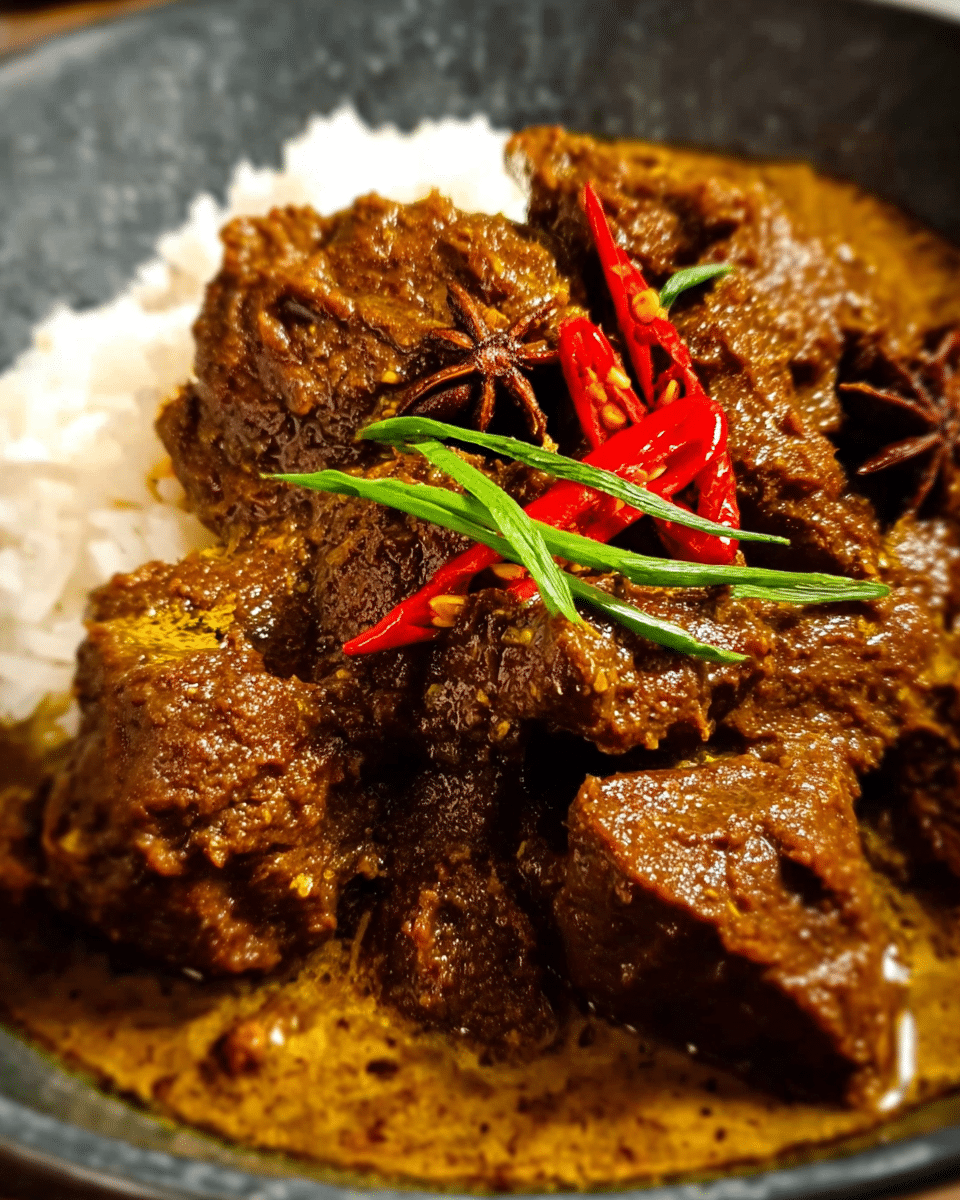The Origins of Rendang
Rendang has its roots in the Minangkabau people of West Sumatra, Indonesia, where it has been a staple for generations. Traditionally, rendang was prepared for ceremonial occasions, such as weddings and religious celebrations, and was often served to honor guests. The slow-cooking process of rendang is an essential part of its rich flavor and texture, with the beef simmered in a variety of spices and coconut milk until it becomes tender and infused with the bold, aromatic flavors of the spices. Over time, rendang has spread throughout Indonesia and beyond, becoming popular in many Southeast Asian countries and earning a place as one of the world’s most delicious and complex stews.
At its core, rendang is a perfect example of Indonesian cuisine, which emphasizes a delicate balance of savory, sweet, sour, and spicy elements. The dish’s complexity comes from the careful layering of these flavors, with each spice contributing its own unique character to the dish. The long cooking time allows the beef to absorb the spices and coconut milk, resulting in a deep, rich flavor that is unmistakable.
The Aromatic Spice Paste
One of the key elements that define Beef Rendang is the spice paste, which is made from a combination of shallots, garlic, red chilies, cumin, and candlenuts. This paste is the foundation of the dish’s flavor profile, offering a fragrant, slightly spicy, and savory base that will infuse the beef as it cooks. Shallots and garlic bring a sweetness and depth to the paste, while the red chilies add a mild heat and complexity. Cumin, a staple spice in many Indonesian dishes, adds a warm, earthy tone, and the candlenuts contribute a smooth, nutty flavor that helps to thicken the sauce and add richness to the dish.
The spice paste is blended into a smooth mixture that will coat the beef, infusing it with a deep, aromatic flavor. The careful balance of these ingredients is what sets rendang apart from other stews or curries, creating a flavor profile that is both bold and nuanced. This spice paste is sautéed in hot oil, releasing its fragrant oils and creating the perfect base for the slow-cooked beef.
The Role of Coconut Milk and Toasted Coconut
Coconut milk is a defining ingredient in rendang, contributing a creamy, rich texture to the dish. In this recipe, both light and thick coconut milk are used, creating a sauce that is both smooth and slightly thickened as it simmers. The coconut milk balances the heat of the spices, adding a subtle sweetness that complements the bold flavors of the beef and spices. It also helps to tenderize the meat, allowing it to become fork-tender as it simmers slowly.
As the beef cooks, the sauce thickens and reduces, concentrating the flavors and allowing the beef to absorb the spices. At the end of the cooking process, toasted coconut is added to the stew, enhancing the creaminess of the dish and adding a rich, slightly caramelized flavor. Toasting the coconut before adding it to the dish intensifies its flavor and adds a delightful texture, making the sauce even more luxurious and flavorful. The toasted coconut gives the rendang a beautiful richness that perfectly balances the spicy and aromatic flavors of the other ingredients.
The Beef: The Heart of the Dish
The beef used in rendang is traditionally a tough cut, such as chuck or brisket, which benefits from slow cooking. The long cooking time allows the collagen in the meat to break down, resulting in tender, juicy pieces of beef that are infused with the complex flavors of the spices and coconut milk. As the beef simmers, it absorbs all of the aromatic ingredients, becoming succulent and flavorful. The slow-cooking method is essential for achieving the melt-in-your-mouth texture that makes rendang so beloved.
The dish’s hearty, comforting nature comes from the richness of the beef, which is perfectly complemented by the thick, aromatic sauce. As the beef simmers, the flavors intensify, creating a complex, savory sauce that coats the meat beautifully. The beef becomes so tender that it practically falls apart, making each bite an unforgettable experience.
Balancing the Flavors
One of the most remarkable aspects of Indonesian Beef Rendang is the balance of flavors. The richness of the beef and coconut milk is balanced by the bright, aromatic spices, creating a dish that is simultaneously rich and refreshing. The addition of lemongrass, star anise, cinnamon, and bay leaves adds a depth of flavor that elevates the dish beyond simple stew. These spices, while pungent on their own, work together to create a harmonious blend that complements the beef and coconut.
Palm sugar is often added to rendang to balance the heat and spice with a touch of sweetness. The sweetness of the palm sugar enhances the richness of the coconut milk and creates a beautifully balanced dish. A splash of white wine vinegar can be added at the end to further balance the flavors, cutting through the richness of the stew and adding a touch of acidity.
The end result is a dish that offers a rich depth of flavor, with layers of heat, sweetness, and aromatic spice. Each bite of rendang is a burst of flavor, with the tender beef and creamy coconut sauce coming together in a truly satisfying way.
Serving Rendang
Indonesian Beef Rendang is traditionally served with steamed rice, which acts as the perfect accompaniment to soak up the flavorful sauce. The combination of the tender beef and rich, aromatic sauce over a bed of fluffy rice is a comforting and satisfying meal. Rendang can also be served with flatbreads, such as naan or roti canai, which help to scoop up the sauce and beef.
In addition to rice or bread, rendang is often served with pickled vegetables, which provide a refreshing contrast to the richness of the stew. The tanginess of the pickled vegetables helps to balance the heaviness of the beef and coconut milk, creating a well-rounded meal.
A Dish for Special Occasions
While Beef Rendang is a dish that can be enjoyed anytime, it is particularly popular for special occasions. The slow cooking process and the complexity of the flavors make it an ideal dish to serve at celebrations or family gatherings. It’s a dish that’s meant to be shared, as the flavors improve over time, making it perfect for leftovers or for making in large batches.
Whether you’re preparing it for a holiday, a family feast, or simply a comforting meal, Indonesian Beef Rendang brings people together with its rich flavors and cultural significance. Its depth of flavor and comforting nature make it a timeless dish that will continue to be enjoyed for generations.
Conclusion: A Taste of Indonesia in Every Bite
Indonesian Beef Rendang is much more than just a stew; it’s a cultural experience, rich in history and tradition. The careful combination of beef, aromatic spices, coconut milk, and toasted coconut creates a dish that is both complex and comforting. Every bite of rendang takes you on a journey through Indonesia’s vibrant culinary heritage, offering a delicious balance of heat, sweetness, and savory depth. Whether served during a special celebration or enjoyed on a cozy evening, rendang is a dish that never fails to impress. With its rich flavor and melt-in-your-mouth beef, Indonesian Beef Rendang is a dish that is sure to become a favorite in your kitchen.






